By Dani Jaworski, The Colonial Williamsburg Foundation’s Manager of Architectural Collections, and Jenn Wilkoski, Shirley and Richard Roberts Architectural Historian, The Colonial Williamsburg Foundation
The early years of the restoration of Colonial Williamsburg’s Historic Area set a new precedent for how historic buildings were studied and treated. Historic materials and building techniques were closely examined so that work was properly conducted. Elements in surviving 18th and early-19th century buildings in the Historic Area and throughout eastern Virginia guided the restoration of the buildings you see in the Historic Area today.
A Discovery of Hints


While inspecting one of our reconstructed buildings, The Red Lion, we noticed that the stair seemed to be older than the building. Looking through a 1951 architectural research report on the Red Lion, the General Notes noted, “The main stair occurs in this hall, and was originally in the two-story colonial house which was wrecked to clear the site for the new Williamsburg Inn.” Amazingly, this meant that a portion of the St. John House stairs had been reused in one of our reconstructed buildings. While paint analysis showed that the stair rails and balusters had been stripped of all antique paint, the sole baluster in our collection retains some of the original colors from the colonial house that is no longer here. This baluster shines a light on the fact that while we have 88 original buildings that we closely monitor, we also have 20th century buildings that contain 18th and 19th century elements that deserve the same protection.
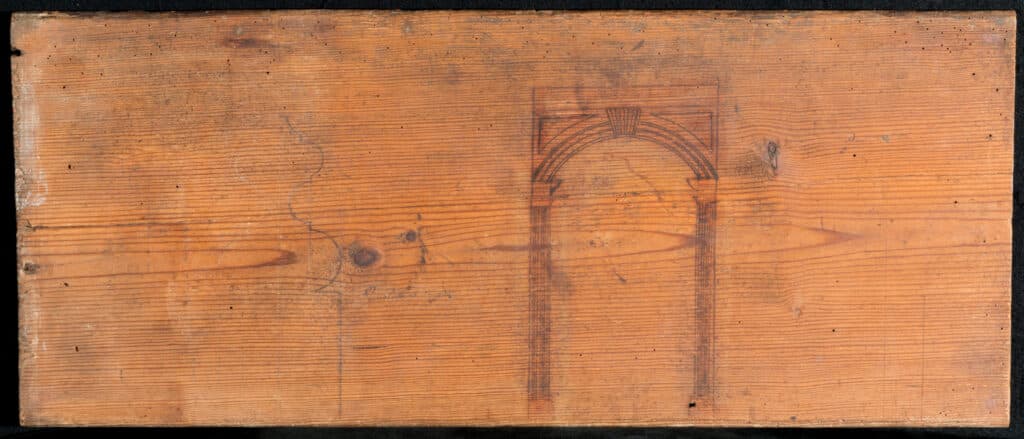
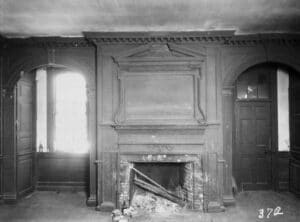
A Drawing – A couple of objects in the collection include extremely rare detailing. We have a late-18th-century wood board with architectural design details drawn on it for Belle Farm, a house that used to stand in Gloucester County, Virginia. The drawing, which is one of the earliest found in Virginia, dates from about 1775-1800. The sketch is a design for a Doric base and arched doorway surround that closely matches images of arches that flanked one of Belle Farm’s internal chimneys. It is believed that the artisan etched the detailed drawing to show the homeowners how his proposed features would look. The etching was discovered and saved with other woodwork when the building was being dismantled in 1930. Colonial Williamsburg’s restoration architects copied the design when constructing arches in several reconstructed Historic Area buildings.
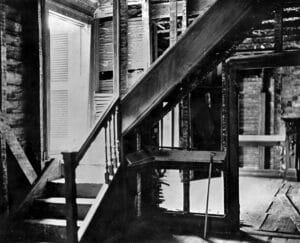
AF-1.22.7. The baluster and stair (still in place just after the fire) were removed during the subsequent restoration of the house.
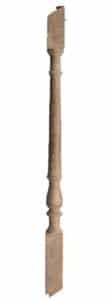
The ca. 1753 baluster did not belong to the main stairway balustrades but instead came from servants’ stairs in the space to the south of the main stairs. The fire caused enough damage to require the removal of the servants’ stairs in the earliest section of the house. A replacement set of stairs was not installed when the house was repaired and updated for the Rockefellers’ occupancy. Even though the baluster is damaged, it is especially important because it is the only known piece to survive from that staircase and is the only Historic Area servants’ stair baluster in our collection.
A Scrutinized Painting Leads to More Hints
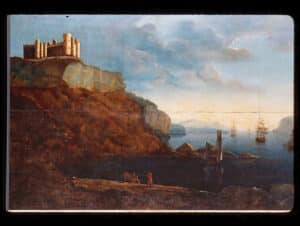
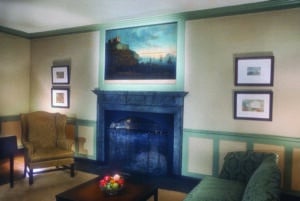
Another one-of-a-kind object that relates to an earlier rendition of one of our 18th century buildings is a painted overmantel from the building formerly known as the George Reid House. The landscape scene is the only surviving piece of evidence from a scenic overmantel in Williamsburg in the 18th century. No records have been found naming the painter or the person who commissioned it, but all agree that it is a traditional Scottish coastline scene. While preparing the overmantel for exhibition, we began a thorough physical investigation of the house as it stands today to see if we could determine a date for the painting.
While a definitive date for the creation of the painting could never be determined since the pigments used in its composition date to a broad swath of the 18th and early-19th centuries, analyzing the painting led to a renewed interest in investigating and better understanding the house itself.
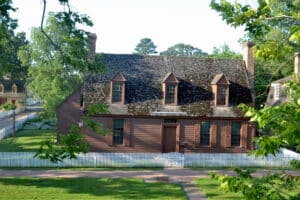
For some time, historians went back and forth about the pedigree of the house on the corner of Duke of Gloucester and Colonial Streets. For many years it was thought that the early-18th-century house was torn down and a new house built around 1790 by Williamsburg merchant, George Reid. The earliest owner we can trace to the property was Edward Baradall, the attorney general for the Virginia colony. In 1739, the property was purchased from Baradall’s estate by Hugh Orr, a Scottish blacksmith, and his wife Catherine. We believe the Orrs made many changes to the house, likely adding the central passage and many outbuildings over their 45-year ownership of the property. While Hugh died in 1764, his wife, Catherine continued to live in and repair the house until her death in 1788. After Catherine’s death, the property was transferred to George Reid and his wife Eve Anderson Reid. After Eve’s death in 1814, it went through a series of owners until Colonial Williamsburg purchased it in 1928. The house was one of the first to be restored by Colonial Williamsburg, and like many of the early restorations, not much was documented at the time.
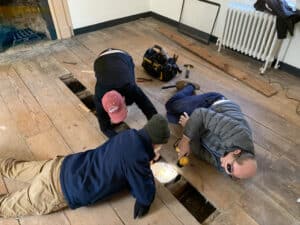
Catherine Orr House
Since the house was originally restored in 1928, new technologies and techniques have emerged to help us better understand this and many other buildings. One such technology, dendrochronology, or the study of tree-ring data, can help us date the building, often to the season the trees were felled. Using a drill with a small coring bit, scientists take samples of the timbers. These core samples are then analyzed to reveal not only how old the tree was, but by using sample data from known locations in tandem with climate records also provides the year it was felled. While we have solid dates for many buildings in the Historic Area, this one continues to elude us due to the fast-growing poplar timbers used in the early construction of the building. We are hopeful that more testing and perhaps creating a dedicated database for Williamsburg in the future will help resolve some of the issues we are encountering.
We also work with our colleagues in the conservation department and the Materials Analysis Lab on paint studies to help determine the finishes and paint colors of the early house. Because certain pigments and formulations have known dates of introduction, we are able to narrow down certain paint layers, much like in archaeological investigations. For instance, zinc was not used in paint until 1845 so any layers that have zinc in them must post-date that time period. One interesting and unusual discovery has been the finding of orpiment, an arsenic sulfide compound used to make a yellow paint. This pigment is highly toxic and very smelly, so finding it in house paint was quite unexpected. We continue to work with conservators as we uncover new areas with potential early paint finish.
Along with the scientific materials analysis, how do we as architectural historians go about studying a building? First, we look at previous scholarly works and reports, and then deep dive into the documents like historic photographs, drawings, insurance policies, probate inventories, and other primary sources, but nothing compares to hands-on physical investigations. In many cases, this means more invasive methods of investigation. At the Orr House, we’ve started to remove plaster in small investigation units to better study the timber frame. Like most of the early restorations, all the historic plaster was removed when the building was restored. This, while now known as a devastating loss as plaster provides many clues such as wall finishes and wallpaper, is actually a benefit to us as it means we can remove modern plaster without worry that we are destroying the historic fabric.
We’ve long puzzled over the framing at the Orr House. Once investigation units were cut into the plaster, we were able to thoroughly investigate the timber frame construction of the building. What we found was intriguing and had a profound impact on how we will interpret the house in the future. As we delved deeper into our investigation, we found more hints that the building might be older than previously thought. This was realized when we began looking at the roof framing at the eaves and found evidence for a construction technique we’ve only seen in the oldest homes in the Tidewater. While not the proverbial “home run” we are always chasing, all signs point to the building being much earlier than thought–perhaps as early as the 1710s.
While this is no smoking gun, we believe we are on the right track to coaxing the Orr House into giving up her secrets. So where do we go from here? Our first step has been to rename the building. Following Colonial Williamsburg tradition, its new name reflects the 18th century resident who lived in or owned the house the longest.
Since we now believe the house is much earlier than once considered, we have changed the name to the Catherine Orr House to reflect her nearly five decades of residence in the building. For now, we continue to investigate the building and uncover more architectural features that help us understand the evolution of the building and of 18th century Williamsburg in general.
Doors in the Architectural Collection
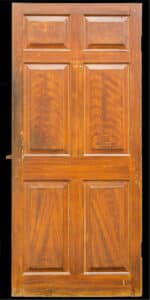
We have all heard about the importance of making a great first impression and doors in your home play a large part in that sentiment. While the main function of the door is to maintain privacy and safety inside the room or house when it is closed, it also illustrates the status level of the various spaces.
An interior door from the Cogar Shop, an 18th-century King & Queen County, Virginia house that was moved to Williamsburg’s Historic Area in 1947, is a perfect example. The raised panels and faux-graining on both sides of the door represent higher-status decorative detailing that was used in 18th and 19th century Williamsburg. Having such detailing on both sides meant that the door connected two higher-status spaces.
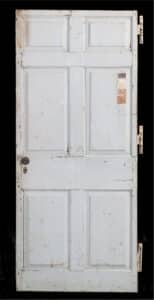
An 18th-century interior door from Wetherburn’s Tavern on Duke of Gloucester Street has raised panels on one side and flat panels on the other. While the raised panel side faced into a public space, the flat panels faced into a secondary space (most likely a closet).
A ca. 1752 exterior door from the Thomas Everard Kitchen near Colonial Williamsburg’s Governor’s Palace perfectly illustrates the difference between higher status and lower status spaces and buildings. While the Cogar and Wetherburn’s doors were designed to impress, the outbuilding’s heavy board and batten door with large iron hinges was simply meant to fill an opening and hide the workspace inside.
All the objects mentioned are on view in the exhibit, Restoring Williamsburg, at the DeWitt Wallace Decorative Arts Museum, one of the Art Museums of Colonial Williamsburg. The exhibit is designed to take the viewer on a visual journey from the start of the Restoration in the 1920s to today.
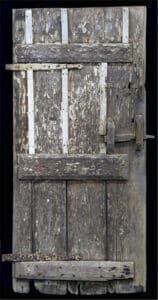
It highlights the Foundation’s architectural collections, explaining how they began and focusing on how they guided the early restoration architects and designers, and how they continue to guide our preservation work today.
Colonial Williamsburg operates the world’s largest living history museum, preserving Virginia’s 18th-century capital as a fully functioning city. Fun, engaging experiences transport guests back in time and highlight the relevance of America’s founding era to contemporary life. The Colonial Williamsburg experience includes more than 600 restored or reconstructed buildings, historic trade shops, renowned museums of decorative arts and folk art, extensive educational outreach programs for students and teachers, lodging, culinary options from historic taverns to casual or elegant dining, the Golden Horseshoe Golf Club featuring 45 holes designed by Robert Trent Jones Sr. and his son Rees Jones, a full-service spa and fitness center managed by Trilogy Spa, pools, retail stores and gardens. The Colonial Williamsburg Foundation is a 501 (c)(3) nonprofit organization; philanthropic support and revenue from admissions, products, and operations sustain its educational programs and preservation initiatives.
Visit www.colonialwilliamsburg.org for more information.

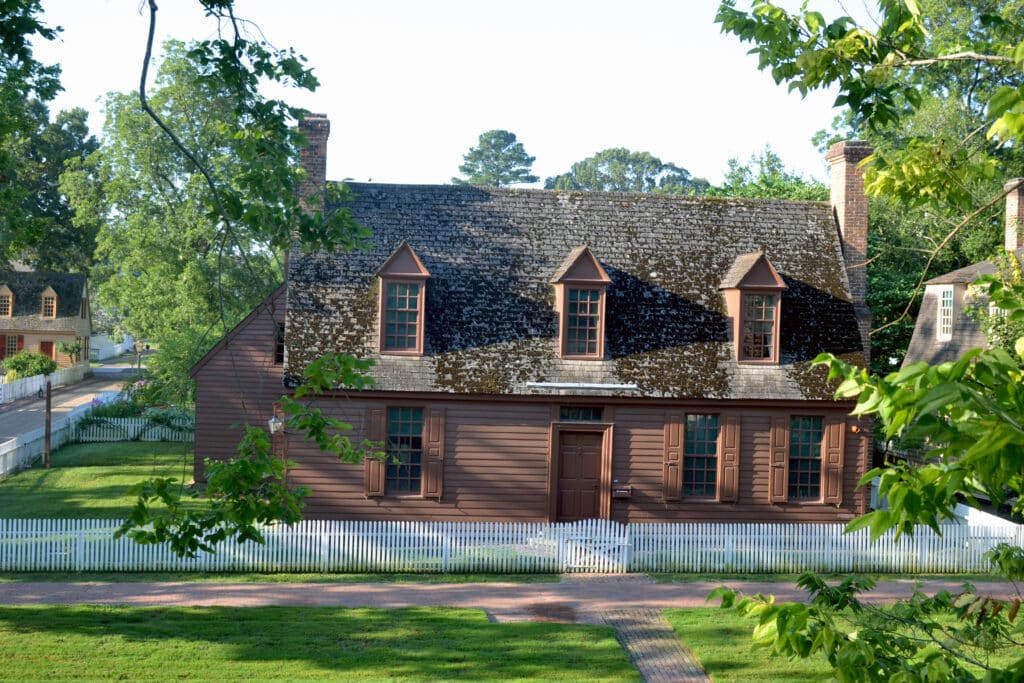



Related posts: